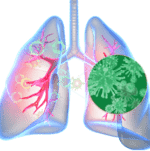Antiviral Activity of Carboxyethylgermanium Sesquioxide (Ge-132) in Mice Infected with Influenza Virus
Hisashi Aso, *Fujio Suzuki, Takusaburo Ebina, and Nakao Ishida Department of Bacteriology, Tohoku University School of Medicine, Sendai, Japan; *Division of Infectious Diseases, Department of Internal Medicine, and Department of Microbiology, University of Texas Medical Branch, and Virology Division, Shriners Burns Institute, Galveston, Texas, U.S.A.; and Tohoku University, Sendai, Japan.

Summary: The protective effect of carboxyethylgermanium sesquioxide (Ge-132) in mice infected with a mouse-adapted strain of influenza virus (H2N2) was investigated. When mice were exposed to a 10 LD50 dose of influenza virus via aerosol and were treated orally with 20 or 100 mg/kg of Ge-132 daily for 6 consecutive days, a significant protective effect was demonstrated.
The anti-viral effect of Ge-132 was indicated by an increase of survivors, a prolongation of mean survival days, an inhibition of the development of lung consolidation, and a decrease of virus titer in lung tissues, as compared to infected control mice treated with phosphate-buffered saline. Natural killer (NK) cell activity in the spleens and lungs of the infected mice was also significantly augmented after the oral administration of Ge-132. In addition, NK cells stimulated with Ge-132 in vivo showed killing activity against NK-insensitive Meth-A cells infected with influenza virus. Because no virucidal or virustatic activities of Ge-132 on the virus were found in vitro, this protective effect in mice against influenza virus infection may be displayed through immunomodulating activi-ties of this compound such as the augmentation of NK cell activity. Key Words: Ge-132—Germanium compound—Antiviral activity—Influenza virus infec-tion—NK cell activity. Read more…
